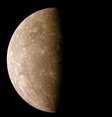Mariner-10 was an American spacecraft launched on 3 November 1973 for a close flyby of planet Venus and Mercury. It was planned to measure the environment, atmosphere and surface of Mars. It was also aimed to perform gravity assist experiments between Mercury and Venus. Mariner-10 was designed under Bruce.C.Murray in Jet Propulsion Laboratory.Total duration of the mission is 1 Year, 4 Months and 12 Days.
Launch:
Mariner-10 was carried by Atlas-Centaur on 3 November 1973 at 12:45 UTC from SLC-36B launch pad. It injected Mariner-10 spacecraft into parking orbit, on the way to Venus the spacecraft separated from rocket. At first its camera were tested to take photograph of Earth and its moons. The spacecraft was tracked by Canopus Star. It also observed the Comet Kohoutek on 21 January 1974. It took 3 months to reach Venus.
Instruments Carried:
- Television Camera
- Infrared Radiometer
- Ultraviolet Spectrometer
- Plasma Detectors
- Charged particle Telescopes
- Magnetometer
- Celestial Mechanics
- Radio Science Experiment
Television Camera:
The total weight of Television Camera is 43.6 kilograms. It consumed 67 watt of power from battery. The Camera only consumed more energy as compared to other five instruments. The camera system mounted in the spacecraft returned 7000 Photographs of Mercury and Venus during its mission of Mariner-10 flyby's.
Infrared Spectrometer:
Infrared Spectrometer was used to detect the infrared radiation radiated by the surface of Mercury and Venus. By using this spectrometer the temperature of both planet surface was calculated. It also had a pair of Cassegrain telescopes and a detector made of Antimony-Bismuth thermopiles to measure as cold as -193 degree to 427 degree Celsius.
Ultraviolet Spectrometer:
UV-Spectrometer were involved in the measurement of UV absorption and UV emissions. It also calculated whether the solar radiation was absorbed at certain wavelengths which would indicate the presence of various gases in atmosphere.
Plasma Detectors:
The Plasma experiment was to detect and study the ionized gases of Sun's Solar wind and its temperature, density of electrons and to study how the planet was affected by solar plasma stream. By using this detector Mariner-10 collected first In Situ solar wind data from inside planet Venus.
Charged Particle Telescope:
The prime aim of this instrument is to observe the cosmic radiation interacted with heliosphere of Venus. It connected with plasma detectors and magnetometers to find some Magnetic fields of planet Mercury and Venus.
Magnetometers:
Magnetometer studied and analyzed the inter-planetary magnetic field of both planets during its flyby's.
Celestial Mechanics and Radio Science Experiment:
This experiment was designed to investigate the mass and gravitational characteristics of Mercury. It was of particular interest, because of the planet is very close to the Sun.
Venus Flyby:
 The spacecraft crossed planet Venus on 5 February 1974 at 17:01 UTC. It became 12th Spacecraft to reach Venus and Eighth to return data to Earth. Mariner-10 was programmed based on the data from Mariner-5 observations. Mariner-10 after reaching Venus it returned 4,165 useful photographs with lots of scientific information, atmospheric composition, geological features, Volcanoes, mountains,cloud features, creators etc..
The spacecraft crossed planet Venus on 5 February 1974 at 17:01 UTC. It became 12th Spacecraft to reach Venus and Eighth to return data to Earth. Mariner-10 was programmed based on the data from Mariner-5 observations. Mariner-10 after reaching Venus it returned 4,165 useful photographs with lots of scientific information, atmospheric composition, geological features, Volcanoes, mountains,cloud features, creators etc..The gravity assist experiment was also success on 5 February 1974. This changed the shape of spacecraft's elliptical orbit around the Sun. Image shown in left side is the processed clear image of Venus taken by Mariner-10 Spacecraft.
First Mercury Flyby:
Image Shows the processed image of Mercury by Mariner-10 spacecraft. Mariner-10 became the first mercury flyby. The first Mercury encounter took place on 29 March 1974 at 20:47 UTC. It flew Mercury for three times one on 21 September 1974 and another on 16 March 1975. After engineering tests on 24 March 1975, radio signal transmission ceased due to the depletion of nitrogen supply.So it was decommissioned on 24 MArch 1975. Since its launch it elapsed 1 year, 4 months and 12 days.
Discoveries:
- Mariner-10 discovered evidence of rotating clouds and very weak magnetic field
- Using Ultraviolet filter, it found Venus Chevron clouds
- It took 2,800 photographs of Mercury and revealed the Moon like surface on Mercury.
- It discovered that atmosphere of Mercury mostly consist of Helium
- It also detected some magnetic field and large iron-rich core.
- Radiometer readings suggest that its night time temperature is -183 degree and daytime is 187 degree Celsius.

























0 comments:
Post a Comment